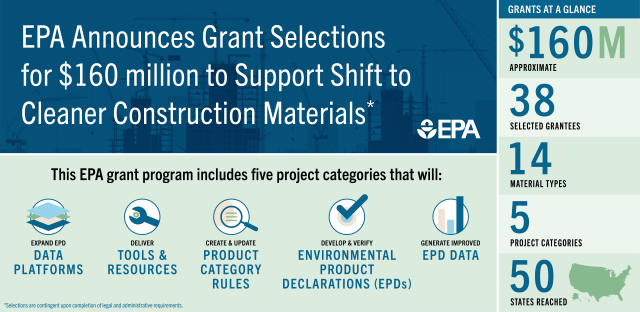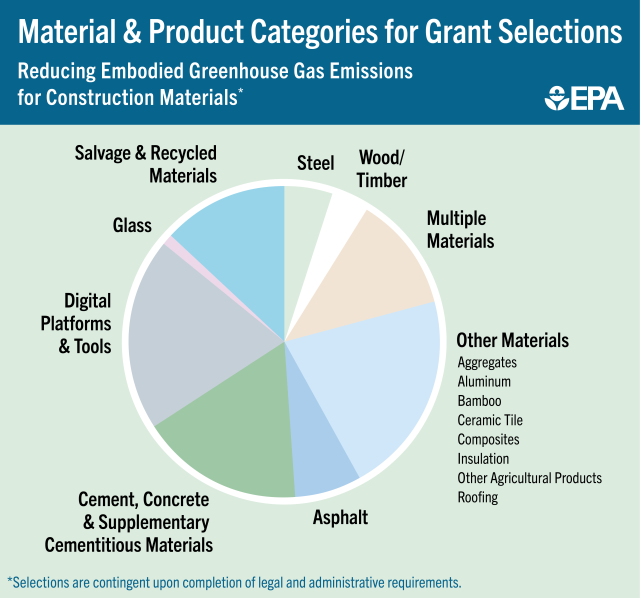Posted by Janet B. Stroud — July 19, 2024 — On July 16, the U.S. Environmental Protection Agency (EPA) announced the selection of 38 grant recipients across the country, totaling nearly $160 million, to support efforts to report and reduce climate pollution from the manufacturing of construction materials and products. EPA estimates that the construction materials used in buildings and other built infrastructure account for more than 15% of annual global greenhouse gas emissions.
Billions of tons of concrete, asphalt, steel, glass and other construction materials and products are required to build, maintain and operate our country’s buildings and infrastructure. The U.S. leads the world in the production of clean construction materials, and these transformative awards from President Biden’s Inflation Reduction Act, touted as the largest climate investment in history, will reduce climate pollution by helping businesses measure the carbon emissions associated with extracting, transporting and manufacturing their products.
The grants will support the Biden-Harris Administration’s Federal Buy Clean Initiative, which leverages the U.S. government’s sway as the largest purchaser on Earth to catalyze demand for clean construction materials used in federal buildings, highways and infrastructure projects. The grants will be awarded to businesses, universities and nonprofit organizations serving all 50 states and will help disclose the environmental impacts associated with manufacturing concrete, asphalt, glass, steel, wood and other materials.
Deputy EPA Administrator Janet McCabe announced the grant selections at Superior Paving, an asphalt facility in Chantilly, Virginia, alongside Richard Willis, PhD, Vice President for Engineering, Research, & Technology at the National Asphalt Pavement Association, and additional federal and industry leaders.
Ranging from $250,000 to $10 million, the grants will help businesses develop robust, high-quality environmental product declarations (EPDs), which show environmental impacts across the life of a product and can catalyze more sustainable purchasing decisions by allowing buyers to compare products. Investments in data and tools will make high-quality EPDs available for 14 material categories, which include both new and salvaged or reused materials.
These efforts will help standardize and expand the market for construction products with lower greenhouse gas emissions. They will make it easier for federal, state and local governments and other institutional buyers to ensure the construction projects they fund use more climate-friendly products and materials.
The grant selections include a diverse range of projects to help measure and ultimately reduce greenhouse gases. For example:
- A company in Georgia will receive funding to report the emissions savings gained by switching from higher-carbon components in cement and concrete to recycled and innovative materials.
- A project in Maine will help a company that manufactures insulation made from wood fiber track the quantity of energy and raw materials used in each of their processes.
- A project in Illinois will help a nonprofit organization that sells reused architectural materials measure how much the salvaged materials reduce carbon emissions.
- A large insulation manufacturer based in Indiana will use grant funding to measure and report greenhouse gas emissions for their full product portfolio.
- A major university will use grant funds to research and document carbon emissions savings from reusing structural steel.
- Several projects will support workforce development to grow the number of sustainable construction professionals available to support these important efforts.
A shared project of improving the robustness of Environmental Product Declarations (EPD) in the cement industry will be led by the Portland Cement Association (PCA) in partnership with the American Coal Ash Association (ACAA), Natural Pozzolan Association (NPA), and Slag Cement Association (SCA). One of the goals of the project is to significantly boost the number of facility-specific EPDs — including those for slag cement producers. SCA hopes to show the sustainability benefits of utilizing slag cement as one of the strongest carbon reduction tools for the cement and concrete industry.
EPA is also announcing expanded technical assistance opportunities to businesses, the federal government and other organizations across America. EPA will initially offer EPD development support and direct businesses to resources to help them measure and reduce the embodied carbon associated with their materials, such as those provided by the ENERGY STAR Industrial program. Federal agencies and their suppliers will be able to compare the climate impact of various materials to drive near-term greenhouse gas emissions reductions. Robust EPD data will be further strengthened by a new label program under development that will identify low carbon construction materials for the growing Buy Clean marketplace.
Together, the grants and technical assistance programs are expected to reduce greenhouse gas emissions and support American jobs. These programs are made possible by the Biden Administration’s Inflation Reduction Act of 2022, which creates significant investments aimed at reducing greenhouse gas emissions associated with the extraction, transport and manufacturing of construction materials and products.
In support of the Federal Buy Clean Initiative, the Inflation Reduction Act also provides more than $2 billion to the General Services Administration to use low embodied carbon materials in the construction and renovation of federal buildings and $2 billion to the Federal Highway Administration to incentivize or reimburse the use of low embodied carbon construction materials in certain transportation projects.
Selections are contingent upon completion of legal and administrative requirements, and grantees are tentatively expected to receive their funding in late summer.
Read summaries of proposed grantee projects (PDF), with the complete list of organizations selected for funding, at EPA.
Learn more about EPA’s Grant Program for Reducing Embodied Greenhouse Gases in Construction Materials and Products.






